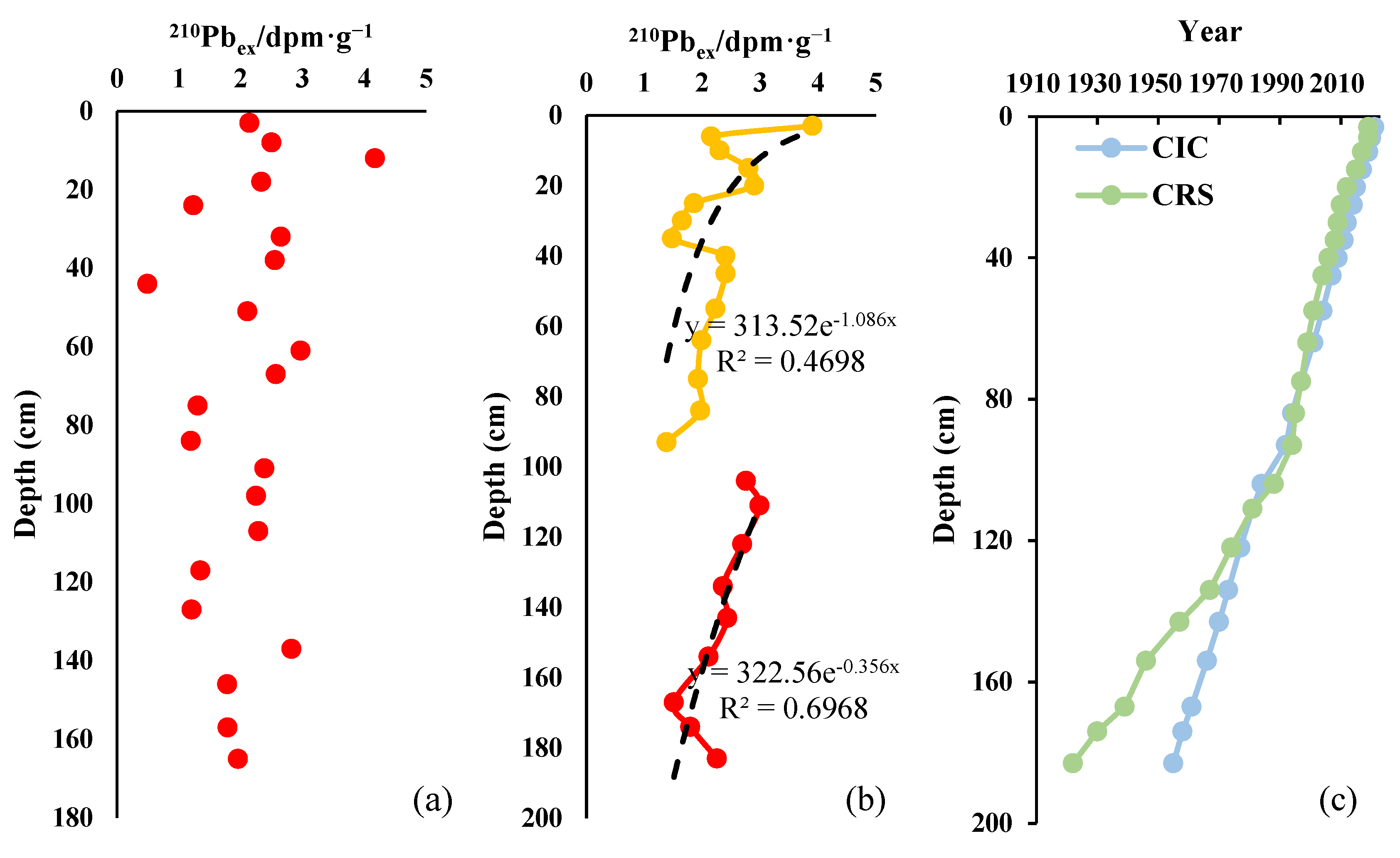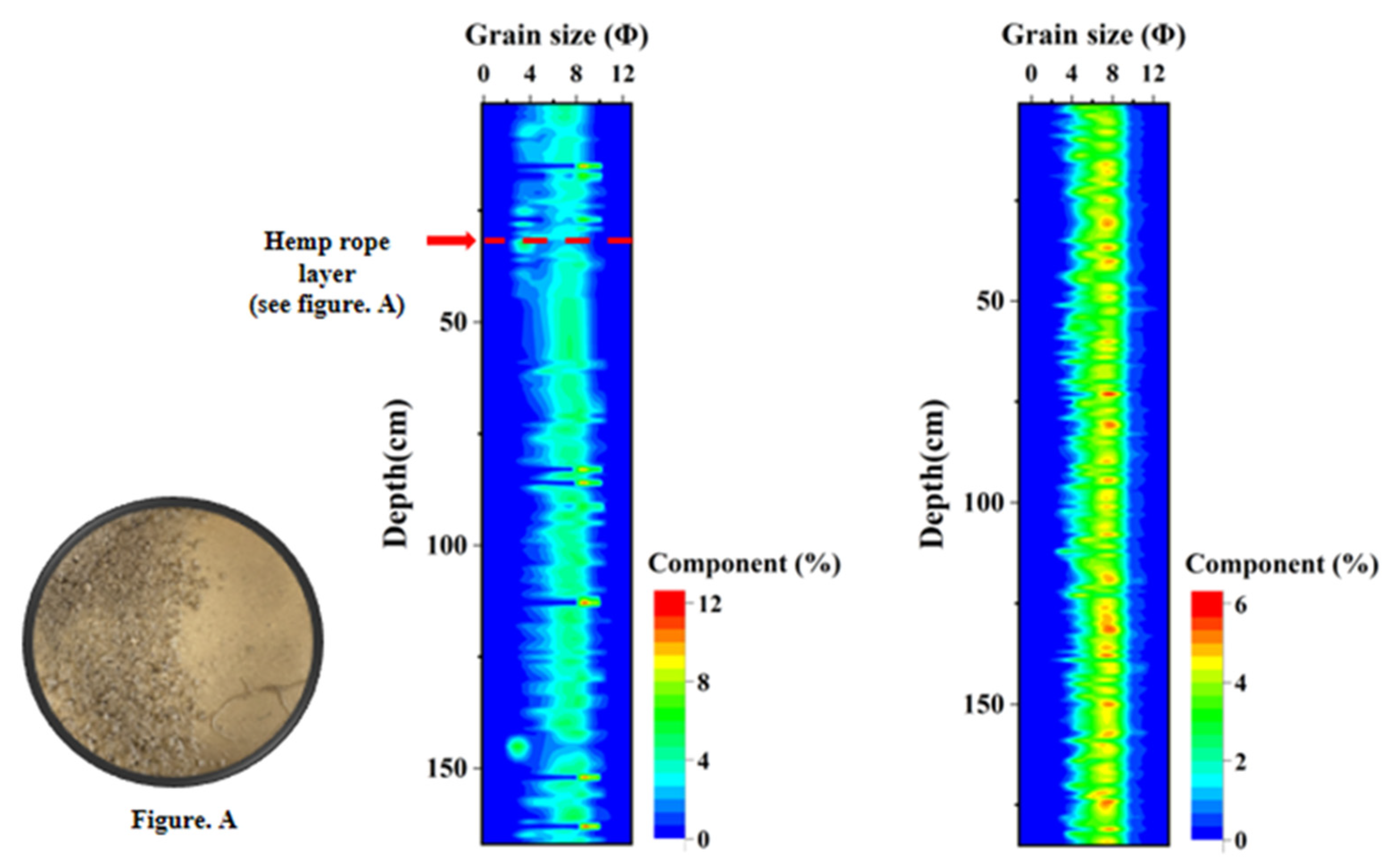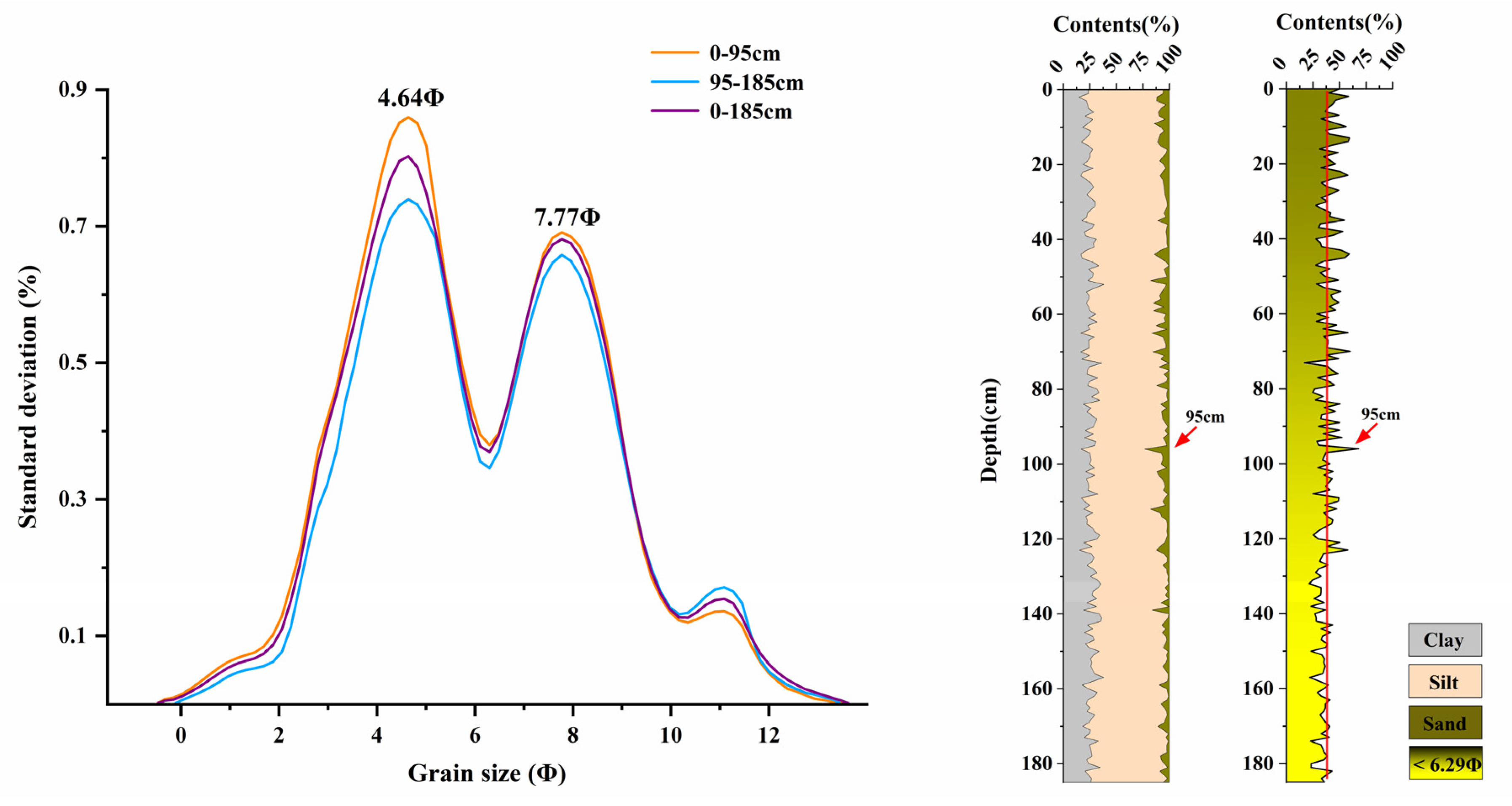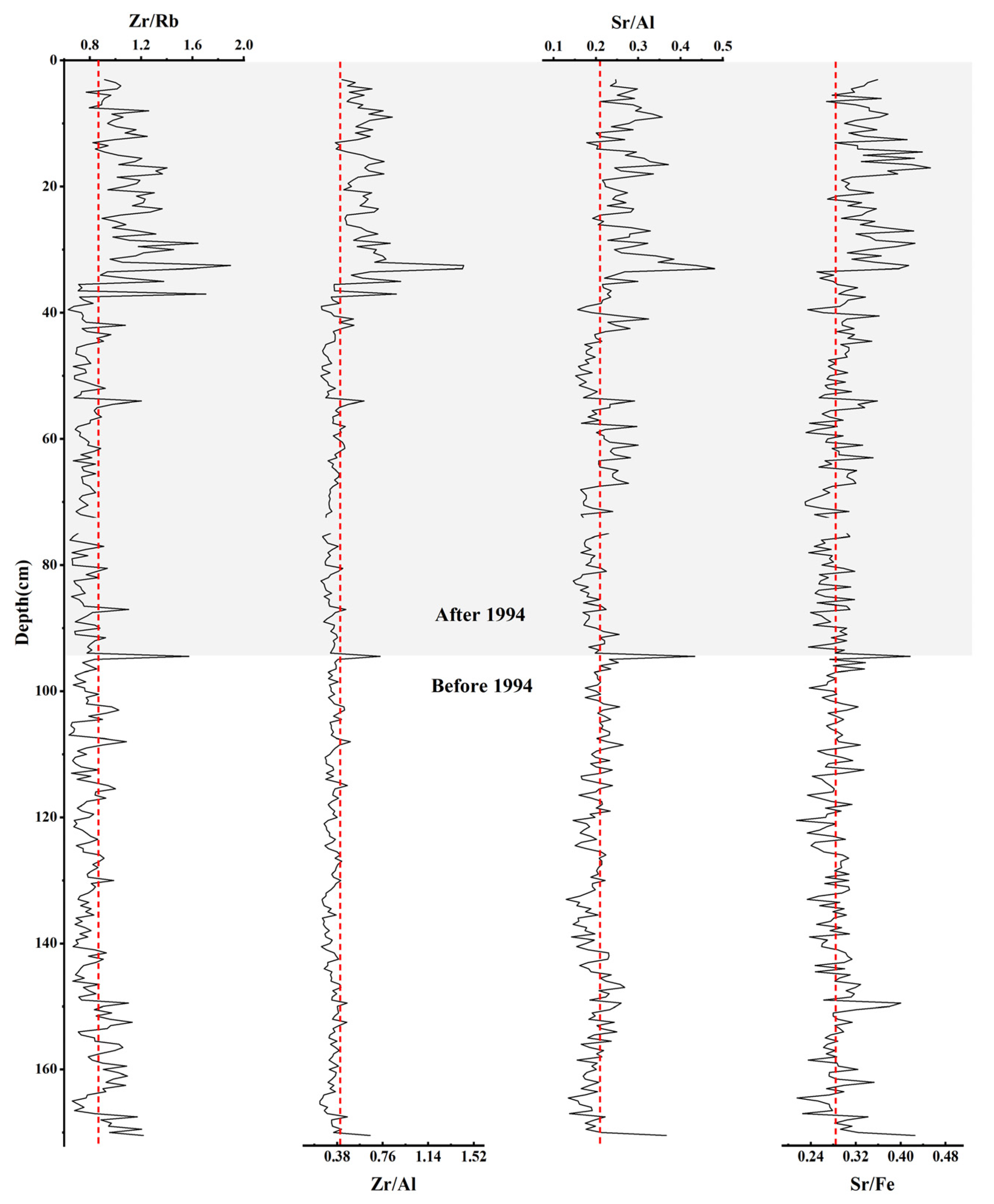Impact of Anthropogenic Activities on Sedimentary Records in the Lingdingyang Estuary of the Pearl River Delta, China
Abstract
:1. Introduction
2. Regional Settings
3. Materials and Methods
3.1. Site Location and Sample Collection
3.2. Laser Particle Size Analysis
3.3. Radionuclide Analysis
3.4. XRF Core Scan
4. Results
4.1. Depth–Age Framework
4.2. Lithology and Particle Size Characteristics
4.3. Geochemical Characteristics of Sediment Elements
5. Discussion
5.1. The Historical Process of Strong Anthropopressure
5.1.1. Human Activities in the Upper Streams of the LE
5.1.2. Human Activities in the LE
- (1)
- Land reclamation
- (2)
- Coastline extensions
- (3)
- Waterway dredging and sand excavation
5.2. Temporal Differences of Sedimentary Records under Varying Intensities of Human Activities
5.3. Spatial Differences of Different-Intensity Human-Perturbed on Sedimentary Records
6. Conclusions
- (1)
- The construction of multiple dams and hydroelectric power stations in the Pearl River Basin has reduced the water and sediment entering the LE, a trend projected to persist. Reclamation in the LE has reshaped the shoreline, extending the coastline to over 300 km and shifting the equilibrium zone of runoff and tidal action downward, thereby accelerating siltation rates. Furthermore, channel dredging and sand mining have introduced new sources of coarse-grained sands and sedimentation centers, leading to increased sedimentation rates, coarser grain size, and alterations in the geochemical characteristics of the sediments.
- (2)
- Based on the CIC model, the sedimentation rate of the LE increased from 2.73 cm/y to 3.36 cm/y after 1994, which is inconsistent with the boundary conditions of decreasing incoming water and sand, and decreasing and stabilizing the frequency of oscillations. This is largely due to strong human activities in the LE, such as sand mining, reclamation, and dredging. The added sediment is likely derived primarily from the erosion of sediments in the inner LE.
- (3)
- There were obvious changes in the sediment grain size composition after anthropogenic disturbance; the sedimentation response may have occurred as early as 1994. The coarse particle fraction of the sediment became more active and the particles coarser than 6.29 Φ were increased (by approximately 7%) after being disturbed by reclamation, channel dredging, ocean dumping, and sand excavation.
- (4)
- As the frequency and intensity of influence by multiple anthropogenic stresses have increased, the vertical variation amplitudes of Zr/Rb, Zr/Al, Sr/Al, and Sr/Fe have increased, with standard deviations rising from 0.12, 0.05, 0.31, and 0.30 to 0.23, 0.19, 0.58, and 0.46, respectively. This change response is consistent with the change in grain size and sedimentation rate.
- (5)
- Although no valid chronological information can be obtained from LD11, which is located in the adjacent channel, the environmental information under the influence of strong disturbance was well recorded, and it can be spatially compared with LD13, which is located in the nearshore siltation zone, and the sedimentary records of the two cores are different. Compared with the nearshore siltation area, the sedimentary layers in the channel area were disturbed at a deeper depth, with a coarser grain size composition and a wider range of grain size variations, a serious inversion of the 210Pbex, and frequent and violent fluctuations of Zr/Rb, Zr/Al, Sr/Fe, and Sr/Al, with no obvious pattern.
Author Contributions
Funding
Institutional Review Board Statement
Informed Consent Statement
Data Availability Statement
Acknowledgments
Conflicts of Interest
References
- Dyer, K.R. Estuaries: A Physical Introduction; Wiley-Interscience: New York, NY, USA; London, UK, 1973; pp. 79–149. [Google Scholar]
- Bianchi, T.S.; Allison, M.A. Large-river delta-front estuaries as natural “recorders” of global environmental change. Proc. Natl. Acad. Sci. USA 2009, 106, 8085–8092. [Google Scholar] [CrossRef] [PubMed]
- Freitas, M.; Andrade, C.; Moreno, J.; MunháJ, M.; Cach, O.M. The sedimentary record of recent (last 500 years) environmental changes in the Seixal Bay marsh, Tagus estuary, Portugal. Geol. Mijnb. 1998, 77, 283–293. [Google Scholar] [CrossRef]
- Joshua, W.; Timothy, D.; Patrick, L.; Lee, G. Historical reconstruction of anthropogenic mercury input from sedimentary records: Yeongsan Estuary, South Korea. Estuar. Coast. Shelf Sci. 2015, 167, 436–446. [Google Scholar] [CrossRef]
- Yuan, X.Q.; Yang, Q.S.; Luo, X.X.; Yu, F.L.; Liu, F.; Li, J.Y.; Wang, Z.H. Distribution of grain size and organic elemental composition of the surficial sediments in Lingding Bay in the Pearl River Delta, China: A record of recent human activity. Ocean Coast. Manag. 2019, 178, 104849. [Google Scholar] [CrossRef]
- Xia, F.; Zhang, Y.Z.; Wang, L.; Liu, D.Z. Sedimentary Sequence and Age of Core NTCJ1 in the Sheyang Estuary, Western South Yellow Sea: A Re-Interpretation. Water 2023, 15, 3617. [Google Scholar] [CrossRef]
- Best, J. Anthropogenic stresses on the world’s big rivers. Nat. Geosci. 2019, 12, 7–21. [Google Scholar] [CrossRef]
- Shin, H.J.; Lee, G.H.; Kang, K.R.; Park, K. Shift of estuarine type in altered estuaries. Anthr. Coasts 2019, 2, 145–170. [Google Scholar] [CrossRef]
- Milliman, J.D.; Farnsworth, K.L.; Jones, P.D.; Xu, K.F.; Smith, L.C. Climatic and anthropogenic factors affecting river discharge to the global ocean, 1951–2000. Glob. Planet. Chang. 2008, 62, 187–194. [Google Scholar] [CrossRef]
- Bentley, S.J.; Blum, M.D.; Maloney, J.; Pond, L.; Paulsell, R. The Mississippi River source-to-sink system: Perspectives on tectonic, climatic, and anthropogenic influences, Miocene to Anthropocene. Earth Sci. Rev. 2016, 153, 139–174. [Google Scholar] [CrossRef]
- Gao, J.J.; Dai, Z.J.; Mei, X.F.; Ge, Z.P.; Wei, W.; Xie, H.L.; Li, S.S. Interference of natural and anthropogenic forcings on variations in continental freshwater discharge from the Red River (Vietnam) to sea. Quat. Int. 2015, s380–s381, 133–142. [Google Scholar] [CrossRef]
- Wu, X.; Wang, H.J.; Bi, N.S.; Saito, Y.; Xu, J.P.; Zhang, Y.; Lu, T.T.; Cong, S.; Yang, Z.S. Climate and human battle for dominance over the Yellow River’s sediment discharge: From the Mid-Holocene to the Anthropocene. Mar. Geol. 2020, 425, 106188. [Google Scholar] [CrossRef]
- Yang, S.L.; Milliman, J.D.; Xu, K.H.; Deng, B.; Zhang, X.Y.; Luo, X.X. Downstream sedimentary and geomorphic impacts of the Three Gorges Dam on the Yangtze River. Earth Sci. Rev. 2014, 138, 469–486. [Google Scholar] [CrossRef]
- Zheng, S.W.; Cheng, H.Q.; Lv, J.S.; Li, Z.J.; Zhou, L. Morphological evolution of estuarine channels influenced by multiple anthropogenic stresses: A case study of the North Channel, Yangtze estuary, China. Estuar. Coast. Shelf Sci. 2021, 249, 107075. [Google Scholar] [CrossRef]
- Zhang, S.R.; Lu, X.X.; Higgitt, D.L.; Chen, C.T.A.; Han, J.T.; Sun, H.G. Recent changes of water discharge and sediment load in the Zhujiang (Pearl River) Basin, China. Glob. Planet. Chang. 2008, 60, 365–380. [Google Scholar] [CrossRef]
- Zhang, Q.; Chen, Y.D.; Jiang, T.; Chen, X.H.; Liu, Z.F. Human-induced regulations of river channels and implications for hydrological alterations in the Pearl River Delta, China. Stoch. Environ. Res. Risk Assess. 2011, 25, 1001–1011. [Google Scholar] [CrossRef]
- Wu, Z.Y.; Saito, Y.; Zhao, D.N.; Zhou, J.Q.; Cao, Z.Y.; Li, S.J.; Shang, J.H.; Liang, Y.Y. Impact of human activities on subaqueous topographic change in Lingding Bay of the Pearl River estuary, China, during 1955–2013. Sci. Rep. 2016, 6, 37742. [Google Scholar] [CrossRef] [PubMed]
- Wei, X.; Cai, S.Q.; Zhan, W.K. Impact of anthropogenic activities on morphological and deposition flux changes in the Pearl River Estuary, China. Sci. Rep. 2021, 11, 16643. [Google Scholar] [CrossRef] [PubMed]
- Yuan, X.Q. Modern Sedimentary Characteristics of Lingding Bay, Pearl River Estuary and Its Implications for Human Activities. Ph.D. Thesis, East China Normal University, Shanghai, China, 2022; pp. 1–114. (In Chinese). [Google Scholar]
- Xia, Z.; Jia, P.H.; Ma, S.Z.; Liang, K.; Shi, Y.H.; Waniek, J.J. Sedimentation in the Lingdingyang Bay, Pearl River Estuary, Southern China. J. Coast. Res. 2013, 66, 12–24. [Google Scholar] [CrossRef]
- Xia, Z.; Jia, P.H.; Chen, L.Y. Dynamics of coastal land use patterns of Inner Lingdingyang Bay in the Zhujiang River estuary. Chin. Geogr. Sci. 2007, 17, 222–228. [Google Scholar] [CrossRef]
- Zeng, W.Z.; Zheng, Z.Y.; Zhang, C.P.; Zhou, P. Sedimentary Records of the Dramatic Environmental Changes in the Lingdingyang Bay of the Pearl River Estuary in Southern China. Ocean Sci. J. 2023, 58, 12. [Google Scholar] [CrossRef]
- Chen, Y.T.; Luo, Z.R. Modern sedimentary velocity and their reflected sedimentary characteristics in the Pearl River mouth. Trop. Geog. 1991, 10, 57–64, (In Chinese with English abstract). [Google Scholar]
- Hu, D.L.; Yang, Q.S.; Wu, C.Y.; Bao, Y.; Ren, J. Changing water and sediment dynamics in the Pearl River network and consequences on water and sediment regimes in the Lingdingyang estuary. Adv. Water Sci. 2010, 21, 69–76, (In Chinese with English abstract). [Google Scholar] [CrossRef]
- Li, M.G.; Han, Z.Y.; Li, W.D.; Xu, T. A Review on the Seabed Evolution and Hydrodynamic Sediment Environmenin Lingdingyang Bay of the Pearl River Estuary. Trans. Oceanol. Limnol. 2019, 41, 20–33, (In Chinese with English abstract). [Google Scholar] [CrossRef]
- Yuan, X.Q.; Yang, Q.S.; Meadows, M.E.; Luo, X.X.; Wang, Z.H. Grain size and organic geochemistry of recent sediments in Lingding Bay, Pearl River Delta, China: Implications for sediment dispersal and depositional processes perturbed by human activities. Anthr. Coasts 2021, 4, 147–167. [Google Scholar] [CrossRef]
- Li, X.; Damen, M.C.J. Coastline change detection with satellite remote sensing for environmental management of the Pearl River Estuary, China. J. Mar. Syst. 2010, 82, S54–S61. [Google Scholar] [CrossRef]
- Yang, L.Z.; Liu, F.; Gong, W.P.; Cai, H.Y.; Pan, H.Z. Morphological response of Lingding Bay in the Pearl River Estuary to human intervention in recent decades. Ocean Coast. Manag. 2019, 176, 1–10. [Google Scholar] [CrossRef]
- Folk, R.L.; Ward, W.C. Brazos River bar: A study in the significance of grain size parameters. J. Sediment. Res. 1957, 27, 3–26. [Google Scholar] [CrossRef]
- Blott, S.J.; Pye, K. GRADISTAT: A grain size distribution and statistics package for the analysis of unconsolidated sediments. Earth Surf. Process. Landf. 2001, 26, 1237–1248. [Google Scholar] [CrossRef]
- Shepard, F.P. Nomenclature based on Sand-Silt-Clay ratios. J. Sediment. Res. 1954, 24, 151–158. [Google Scholar] [CrossRef]
- Pszonka, J.; Schulz, B.; Sala, D. Application of mineral liberation analysis (MLA) for investigations of grain size distribution in submarine density flow deposits. Mar. Pet. Geol. 2021, 129, 105109. [Google Scholar] [CrossRef]
- Pszonka, J.; Godlewski, P.; Fheed, A.; Dwornik, M.; Schulz, B.; Wendorff, M. Identification and quantification of intergranular volume using SEM automated mineralogy. Mar. Pet. Geol. 2024, 162, 106708. [Google Scholar] [CrossRef]
- Sanchez-Cabeza, J.A.; Ruiz-Fernández, A.C. 210Pb sediment radiochronology: An integrated formulation and classification of dating models. Geochim. Cosmochim. Acta 2012, 82, 183–200. [Google Scholar] [CrossRef]
- Kumar, A.; Hage-Hassan, J.; Baskaran, M.; Miller, C.J.; Selegean, J.P.; Creech, C.T. Multiple sediment cores from reservoirs are needed to reconstruct recent watershed changes from stable isotopes (δ13C and δ15N) and C/N ratios: Case studies from the mid western united states. J. Paleolimnol. 2016, 56, 15–31. [Google Scholar] [CrossRef]
- Goldberg, E.D.; Koide, M.; Schmitt, R.A.; Smith, R.H. Rare Earth Distributions in the Marine Environment. J. Geophys. 1963, 68, 4209–4217. [Google Scholar] [CrossRef]
- Xue, C.F.; Yang, Y.; Zhao, P.P.; Wei, D.Y.; Gao, J.H.; Sun, P.; Huang, Z.Y.; Jia, J.J. Impact of Ship Traffic on the Characteristics of Shelf Sediments: An Anthropocene Prospective. Front. Mar. Sci. 2021, 8, 678845. [Google Scholar] [CrossRef]
- Catherine, C.G.; Witold, S.; Shinozaki, T. Applications of geochemistry in tsunami research: A review. Earth Sci. Rev. 2017, 165, 203–244. [Google Scholar] [CrossRef]
- Tian, Y.; Fan, D.J.; Zhang, X.L.; Chen, B.; Wang, L.; Liu, M.; Yang, Z.S. Event deposits of intense typhoons in the muddy wedge of the East China Sea over the past 150 years. Mar. Geol. 2019, 410, 109–121. [Google Scholar] [CrossRef]
- Zhou, L.; Gao, S.; Yang, Y.; Zhao, Y.Y.; Han, Z.C.; Li, G.C.; Jia, P.H.; Yin, Y. Typhoon events recorded in coastal lagoon deposits, southeastern Hainan Island. Acta Oceanol. Sin. 2017, 36, 37–45. [Google Scholar] [CrossRef]
- Yang, Z.X.; Xue, C.F.; Yang, Y.; Zhou, L.; Ai, Q.; Gao, J.H.; Jia, J.J. A 100-year reconstruction of typhoon events on the inner shelf of the East China Sea: Coupling of meteorological observations and sedimentary records. Haiyang Xuebao 2020, 42, 119–129, (In Chinese with English abstract). [Google Scholar] [CrossRef]
- Wu, C.S.; Yang, S.L.; Liu, Y.P. Quantifying the anthropogenic and climatic impacts on water discharge and sediment load in the Pearl River (Zhujiang), China (1954–2009). J. Hydrol. 2012, 452–453, 190–204. [Google Scholar] [CrossRef]
- Wu, Z.Y.; Milliman, J.D.; Zhao, D.N.; Zhou, J.Q.; Yao, C.H. Recent geomorphic change in LingDing Bay, China, in response to economic and urban growth on the Pearl River Delta, Southern China. Glob. Planet. Chang. 2014, 123, 1–12. [Google Scholar] [CrossRef]
- Liu, F.; Yuan, L.R.; Yang, Q.S.; Ou, S.Y.; Xie, L.L.; Cui, X. Hydrological responses to the combined influence of diverse human activities in the Pearl River delta, China. Catena 2014, 113, 41–55. [Google Scholar] [CrossRef]
- Xie, L.L.; Liu, X.; Yang, Q.S.; Huang, G.L. Variations of current and sediment transport in Lingding Bay during spring tide in flood season driven by human activities. J. Sediment. Res. 2015, 60, 56–62, (In Chinese with English abstract). [Google Scholar] [CrossRef]
- Chen, K.L.; Dong, H.Y.; Jia, L.W.; He, Z.X. Depocentre transfer in the Lingdingyang estuary: Interferences from natural and anthropogenic forcings. Ocean Coast. Manag. 2020, 185, 1–15. [Google Scholar] [CrossRef]
- Chen, K.L.; He, Z.X.; Liu, J.; Lin, Y.T.; Jia, L.W. Long-term morphological evolution and its mechanism of Lingdingyang Estuary: Interferences from anthropogenic forcings. Mar. Geol. 2022, 450, 106856. [Google Scholar] [CrossRef]
- Zhang, W.; Xu, Y.; Hoitink, A.J.F.; Sassi, M.G.; Zheng, J.H.; Chen, X.W.; Zhang, C. Morphological change in the Pearl River Delta, China. Mar. Geol. 2015, 363, 202–221. [Google Scholar] [CrossRef]
- Tang, M.Q.; Zhang, Z.Q.; Xing, Y.Q. Environment monitoring of offshore sand mining in Pearl River estuary. Procedia Environ. 2011, 10, 1410–1415. [Google Scholar] [CrossRef]
- Zhang, T.; Niu, L.X.; He, F.T.; Liu, F.; Luo, X.X.; Yang, Q.S. Anthropogenic Impact on Evolution of Lingding Bay Sedimentary Framework. Acta Sediment. Sin. 2021, 40, 753–764, (In Chinese with English abstract). [Google Scholar]
- Luo, X.L.; Zeng, E.Y.; Ji, R.Y.; Wang, C.P. Effects of in-channel sand excavation on the hydrology of the Pearl River Delta, China. J. Hydrol. 2007, 343, 230–239. [Google Scholar] [CrossRef]
- Ying, Q.; He, J.; Xin, W.J. Influence of giant artificial sand pits on the natural evolution of Lingding Bay. Adv. Water. Sci. 2019, 30, 915–922, (In Chinese with English abstract). [Google Scholar] [CrossRef]
- Liu, P.R.; Wen, P.; Zhou, Z.F. Analysis of influencing factor on shoal and thoughdevelopment of Lingdingyang Bayat Zhujiang Estuary. J. Oceano. Taiwan. Stra. 2000, 19, 119–124. (In Chinese) [Google Scholar]
- Wong, L.A.; Chen, J.C.; Dong, L.X. A model of the plume front of the Pearl River estuary, China and adjacent coastal waters in the winter dry season. Cont. Shelf Res. 2004, 24, 1779–1795. [Google Scholar] [CrossRef]
- Zhao, D.N. Morphological Evolution of the Pearl River Delta in the Past 165 Years and Its Response to Human Activities. Ph.D. Thesis, Zhejiang University, Hangzhou, China, 2017; pp. 1–232. (In Chinese). [Google Scholar]
- Wang, L.; Fan, D.J.; Zhang, X.L. The impact of Artificial Channel Dredging on Inshore Marine Sedimentation: Taking the Huludao Harbor for Example. J. Ocean Univ. China 2012, 40, 88–96, (In Chinese with English abstract). [Google Scholar] [CrossRef]
- Wang, Q.; Wang, X.L.; Li, X.Y.; Wang, X.; Zhan, C. Grain size characteristics and coarsening phenomenon of inter-tidal flat surficial sediment along the abandoned southern Yellow River Sub-delta. Quat. Sci. 2017, 37, 353–367, (In Chinese with English abstract). [Google Scholar] [CrossRef]
- Yang, H.F.; Yang, S.L.; Meng, Y.; Xu, K.F.; Luo, X.X.; Wu, C.S.; Shi, X.F. Recent coarsening of sediments on the southern Yangtze subaqueous delta front: A response to river damming. Cont. Shelf Res. 2018, 155, 45–51. [Google Scholar] [CrossRef]
- He, W. Bifurcated Mechanism and Its Impact on Flood Discharge and Saline Intrusion in Pearl River Estuary. Master’s Thesis, East China Normal University, Shanghai, China, 2012; pp. 1–127. (In Chinese). [Google Scholar]
- Yang, Q.S.; Fu, L.X.; Wei, W.; Jia, L.W.; Li, B.; Wang, H.; Huang, E.M. Study on the structural evolution and dynamic balance of the shoal and channel in the Huangmaohai Estuary of the Zhujiang River. Haiyang Xuebao 2023, 45, 68–81, (In Chinese with English abstract). [Google Scholar] [CrossRef]
- Chu, N.Y. The Evolution of Lingding Bay Channel-Shoal System Under Anthropogenic Influence; Sun Yat-sen University: Guangzhou, China, 2020; pp. 1–262. (In Chinese) [Google Scholar]










| Zr/Rb | Zr/Al | Sr/Al | Sr/Fe | |
|---|---|---|---|---|
| Peak value of 94.5 cm | 1.58 | 0.73 | 0.43 | 0.41 |
| Overall standard deviation | 0.19 | 0.15 | 0.49 | 0.40 |
| Upper standard deviation | 0.23 | 0.19 | 0.58 | 0.46 |
| Lower standard deviation | 0.12 | 0.05 | 0.31 | 0.30 |
| Year | Before 1990s | 1996 | 2005 | 2017 |
|---|---|---|---|---|
| Coastline length (km) | 216.4 | 234.3 | 275.8 | 301.7 |
| Water area (km2) | 1309.7 | 1195.5 | 1152.1 | 1121.7 |
| Mean water depth (m) | 6.19 | 6.1 | 5.99 | 6.07 |
Disclaimer/Publisher’s Note: The statements, opinions and data contained in all publications are solely those of the individual author(s) and contributor(s) and not of MDPI and/or the editor(s). MDPI and/or the editor(s) disclaim responsibility for any injury to people or property resulting from any ideas, methods, instructions or products referred to in the content. |
© 2024 by the authors. Licensee MDPI, Basel, Switzerland. This article is an open access article distributed under the terms and conditions of the Creative Commons Attribution (CC BY) license (https://creativecommons.org/licenses/by/4.0/).
Share and Cite
Liu, D.; Lin, Y.; Zhang, T.; Huang, E.; Zhu, Z.; Jia, L. Impact of Anthropogenic Activities on Sedimentary Records in the Lingdingyang Estuary of the Pearl River Delta, China. J. Mar. Sci. Eng. 2024, 12, 1139. https://doi.org/10.3390/jmse12071139
Liu D, Lin Y, Zhang T, Huang E, Zhu Z, Jia L. Impact of Anthropogenic Activities on Sedimentary Records in the Lingdingyang Estuary of the Pearl River Delta, China. Journal of Marine Science and Engineering. 2024; 12(7):1139. https://doi.org/10.3390/jmse12071139
Chicago/Turabian StyleLiu, Dezheng, Yitong Lin, Tao Zhang, Enmao Huang, Zhiyuan Zhu, and Liangwen Jia. 2024. "Impact of Anthropogenic Activities on Sedimentary Records in the Lingdingyang Estuary of the Pearl River Delta, China" Journal of Marine Science and Engineering 12, no. 7: 1139. https://doi.org/10.3390/jmse12071139




